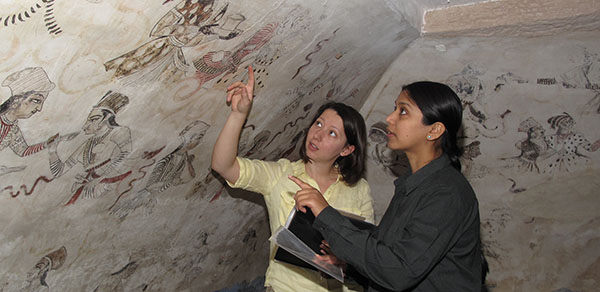Located in northwest India, a two hour drive from the fortress city of Jodhpur in Rajasthan lies the Nagaur-Ahhichatragarh Fort.
Begun in the 12th century on the remains of a fourth-century mud outpost and standing at the crossroads of developing trade routes, the fort was expanded by successive rulers until the mid-18th century. The fort is one of the finest examples of Rajput-Mughal architecture – but over the years, this large fortified complex of palaces, elaborate gardens, temples and a mosque had fallen into dilapidated ruin.
A series of Getty Foundation grants over the past twenty years has enabled the Mehrangarh Museum Trust to undertake a multi-year conservation of the fort, using a blend of both traditional building methods developed by local craftsman and more modern scientific techniques.

Nagaur Fort, exterior, before, during and after conservation work. Photos courtesy of the Ahhichatragarh-Nagaur Fort, Mehrangarh Museum Trust
Fast forward nearly two decades since the Getty Foundation’s first grant, and the fort’s extraordinary wall system has now been preserved, restored, and strengthened. In 2002, the Getty-supported conservation work was recognized with a UNESCO Award for Excellence in Cultural Heritage Conservation.
Most recently, Getty funds enabled students and faculty from the Courtauld Institute in London to participate in the conservation of the wall paintings at the Fort, together with their Indian colleagues. This project focused on the artwork in the Sheesh Mahal, or Palace of Mirrors, which are among the most important examples of the fine, elongated figural style characteristic of Nagaur.
During this last phase of the Getty project, the Courtauld team focused on key conservation treatments including grouting, plaster repairs, consolidation of areas of painting that had fallen away, and salt removal from the surface of the paintings that had built up over time, damaging the artwork.

Stephanie Bogin and Madhu Rani assessing condition of wall paintings in the Sheesh Mahal. © Courtauld Institute of Art

Nagaur, Sheesh Mahal: vault painting with ladies amid clouds and lightning bolts. © Courtauld Institute of Art
This aspect of the conservation has just recently concluded, and the interior results are as beautifully impressive as the exterior results have been.

Nagaur Fort Interiors, before and after conservation.
Left image, courtesy of the Ahhichatragarh-Nagaur Fort, Mehrangarh Museum Trust . Image on right, by Neil Greentree.
The conservation work supported by the Getty Foundation at Nagaur is significant because remarkable historic architecture has been preserved, but equally important is the fact that the project has resulted in the training of Indian conservators – ensuring that the knowledge and techniques utilized at Nagaur will carry on.
The project also serves as a model for the conservation of historic architecture in the region and in the field as a whole. The results of the architectural conservation work have been published as a book written by project leader Minakshi Jain and others (published by AADI in India), and the results of the conservation of the wall paintings at the Sheesh Mahal are available as a pdf from the Courtauld.
As well, the Getty grants have attracted other funders who are supporting new projects at Nagaur.
Today, after a dramatic transformation, Naguar Fort is a 35-acre complex with four main palaces and more than 50 smaller buildings, surrounded by two fortification walls and—despite the arid climate—by extensive gardens, fountains, pools, and water systems.
This past weekend, the Wall Street Journal featured an article about Naguar and its importance. As well, it was recently announced that Nagaur Fort is a shortlisted nominee for the 2013 Aga Khan Award for Architecture. The prestigious award is conferred in recognition of architectural excellence in the field of historic preservation, reuse and area conservation, as well as landscape design and improvement of the environment. A handful of finalists will ultimately be selected and the winner announced at a ceremony to be held in Lisbon in September 2013. This nomination speaks volumes about the collaborative, important work that has been accomplished by the many partners on this project.
Incidentally, the grant to Nagaur Fort is not the Getty Foundation’s only involvement in India. The Foundation has awarded eighteen grants in the country, such as conservation projects for The City Palace Complex in Udaipur and the Wanla Fortress and Monastery in Lower Ladakh or most recently a Connecting Art Histories grant to Jawarhal Nehru University in New Delhi. Visit www.getty.edu/foundation to check out some of our other projects around the globe.





My experience with restoration and conservation is limited to a couple of nice antiques that I’ve acquired over the years. Having traveled to India a few times and marveled at the depth and breadth of the culture, truly many many thanks to the Getty Foundation for helping preserve these relics. Apart from their great beauty, architectural design and unique structural techniques that went into their construction, the ancient wisdom that these edifices impart is priceless. I now have another reason to return to India…
Thank you, George, for your comment. As a member of the Getty Foundation staff, I have loved following the progress of the Nagaur fort and seeing the conservation project unfold. I hope to one day be able to visit like you, so here’s to our paths crossing in Rajasthan!–Katie, Getty Foundation
i believe that restoration has given this place the soul it required for its body.
I recently had the pleasure of visiting Nagaur fort and must commend for the incredible restoration work that has taken place. I was greatly inspired by the visit and blogged about it over here: http://iamjustavisualperson.blogspot.com/2013/09/stories-of-historical-theatre-nagaur.html. Please do have a read!
I look forward to visiting the fort once again:)
its good for me, because of I am working on Economic and Social History of Nagaur.